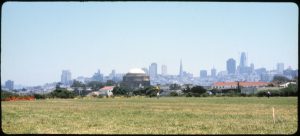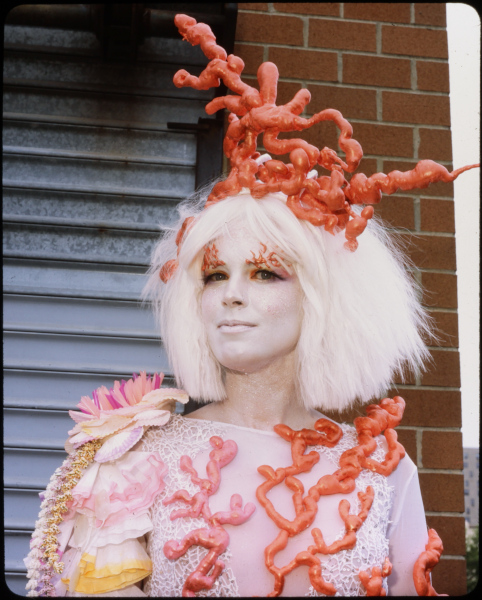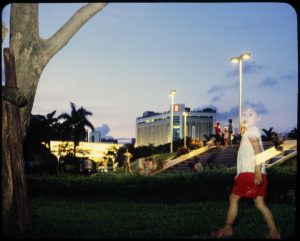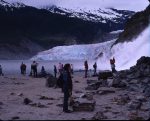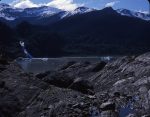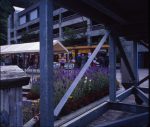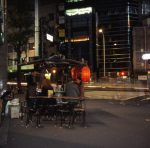This is Jim Harp’s contribution for loop d20, grandfathered in from loop 20 of MF3D Folio II managed by Brian Reynolds.
Left and Right
If the Juneau tourists get a bus to the Mendenhall Glacier, a mile long walk along the willows on the lake shore will bring them to the bottom of Nugget Creek. It offers a nice waterfall, and good view of the glacier.We’ve been here before.
And if one walks several miles up the “left” side of the lake, and climbs a little, it is much quieter and less crowded. Not many unguided tourists make it this far up the trail, so when I meet one I try to make them feel welcome. If the lenses in your viewer are good, you can see the crowd of tourists on the beech at the base of the waterfall.
Twenty years ago, all the open water in both images was ice. The face of the glacier was just past the rightmost iceberg in the second image. At that time, the bedrock was below more than 100′ of ice, and Nugget Falls disappeared under the edge of the glacier.
Both images are from my TL120, Nugget Falls has been captured with Kodak E100G rather than my usual Provia.
Town and Tours
Juneau is historically a gold town. More recently, it is a tourist town. On a ‘good’ day, cruise ships can deliver more than 15,000 passengers to shore. And when all those people get ashore, they need to find something to do. Most of the ships work hard to sell package tours on board to their captive audience, but there are still folks on the sidewalks ready to help put tourists on buses out to the glacier or to another dock where they can grab a whale-watch tour.
Most of the vendors are seasonal workers. They arrive from Outside at the start of the season, rent their booth, and sell tours on commission. They’re assertive, but friendly. I’m not often mistaken for a tourist (wrong clothing and not enough tan), but when I am I listen to their pitch before turning them down.
Both of these are from my TL120 on Provia.
Down the Throat
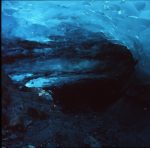 As a bonus image, I’m including a little bit of blue. Like all of my under-glacier images, the light is dim and the location is long gone.
As a bonus image, I’m including a little bit of blue. Like all of my under-glacier images, the light is dim and the location is long gone.
I’m standing in the stream which has cut its way under the ice. The ground is gravel over bedrock, and the deeper one goes the thicker the layer of gravel is. By this point, the gravel is thick enough so the stream is completely contained in the gaps between the stones. The running water carries heat under the ice which creates a gap. Then warm air start to move through and widen the gaps. The color variation in the ceiling is from the variation in thickness and sand content.
I’ve tried several times to try to duplicate this image by print and by film. In call cases, the color reproduction has stymied me. The colors reproduced by the film are not easily obtainable in any of the ink or film-recorder color spaces I’ve tried. I’ll try again in a few more years. Until then, please enjoy this original with all of its subtle colors.
Enter The Dragon Folio
 Adapted from “A Complete Guide to Heraldry” by Arthur Charles Fox-Davies
Adapted from “A Complete Guide to Heraldry” by Arthur Charles Fox-Davies
To provide a bit of history, originally there were two independently organized sets of folios:
- “MF3D Folio I” managed first by Greg Erker, and later by Sam Smith.
- “MF3D Folio II” managed by Brian Reynolds.
The comments page for both sets of folios was a custom-written piece of software by Joel Alpers. When John Thurston took over the management of “MF3D Folio I – Alpha” from Sam Smith in 2008, he went looking for an comments solution with a few more features than the jkalpers comment page. John ultimately developed this comments site powered by WordPress. When John assumed management of “Folio I – Beta” in 2009, its comments were also re-hosted here. Beta was retired in 2012, and its members rolled into Alpha.
The jkalpers comments page had continued to be used by “MF3D Folio II” up until early 2017, when the site went down. Tragically, the source code and admin password to the server running the software were lost, along with the archive of the many years of comments. The folio continued on for a while without a comments solution. In April 2019, Brian Reynolds transferred management of “MF3D Folio II” to me.
At this time, John generously offered to expand this WordPress site to be able to host comments from “MF3D Folio II”, so once again all of the active MF3D folio comments pages are consolidated in one place. The “MF3D Folio II” was renamed “Dragon Folio” under the suggestion of Boris Starosta. This name was chosen as to not be confused with the other active folio at the time of this writing, “Folio A”.
Here’s to many successful years of MF3D folios!
Gi-Me Gelato
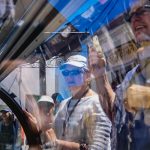
Shot through the side of the Gelato Vendor’s stand, in Rome, I think. It was a quick grab-shot, hoping for the best. Provia 100 – Sputnik.
Atlantis Books
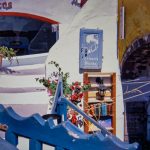
Atlantis Book store on one of the Greek Islands. I must have opened up one stop from Sunny 16 to keep from losing all detail in the shaded store entrance. So, the stark white walls are almost blocked up, but I had to do it -what an amazing scene! I left that Tilley Hat on the airplane, coming home.
Aft-Deck Morn
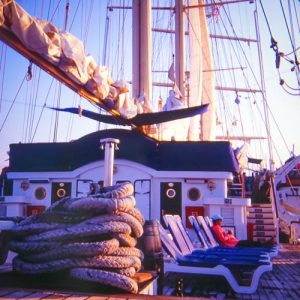
This shot, made early one morning, gives a feel for the atmosphere on the boat. They usually had at least some of the sails up, even when under power. We boarded in Istanbul and sailed/motored to the Islands first, and then on to Corinth and Athens. Our cabin was through those doors behind the rope, and down the stairs. We had a porthole just above the waterline – very peaceful.
I thought this looked a bit saturated for Provia, and sure enough, looking back at the rest of the roll it is RVP100 -Velvia100. I had forgotten that I took any Velvia on the trip, so I mislabeled the view itself. Seems as though Velvia is a good bit “softer” in sharpness than Provia. Consulting the image/data made on my iPhone, using the Pocket Light Meter app,I used 1/60th at f-16.
Sea and Santorini
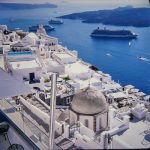
Sea and Santorini
Santorini is one of the Greek Islands we visited during a “Journeys of Paul” tour that Diana and I were on in June of 2017. Our vessel is the sailing craft in the upper left corner of the view, also depicted in Aft-Deck Morn, one of my other views in this round – quite an amazing boat. This was taken with my Sputnik, the only film camera I had on the voyage. Pretty sure I used the Sunny 16 Rule, shooting at 1/125.
Shinjuku Noodle Booth Tokyo
Miracle Mile – Coral Gables Florida
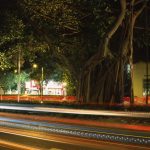 The center island of the Miracle Mile in Coral Gables is lined with these trees. I used a TL-120 on a tripod with a Vivitar 285H fill flash, this was taken after sunset. The fill flash brings out a little touch of detail in the passing cars. I used an incident meter to determine the exposure, hoping to bring out the detail in the trees at the expense of blowing out the store in the background. I think this was a 30 seconds at f22.
The center island of the Miracle Mile in Coral Gables is lined with these trees. I used a TL-120 on a tripod with a Vivitar 285H fill flash, this was taken after sunset. The fill flash brings out a little touch of detail in the passing cars. I used an incident meter to determine the exposure, hoping to bring out the detail in the trees at the expense of blowing out the store in the background. I think this was a 30 seconds at f22.
Infinity Pool – Singapore
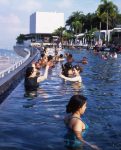 This is the famous Infinity Pool at the top of the Sands three-tower hotel in Singapore. You’ll find a lot of images online of this pool that feature the illusion that the back edge of the water drops off to the Singapore skyline, you’d think swimmers were in danger of falling off. This shot shows why they aren’t.
This is the famous Infinity Pool at the top of the Sands three-tower hotel in Singapore. You’ll find a lot of images online of this pool that feature the illusion that the back edge of the water drops off to the Singapore skyline, you’d think swimmers were in danger of falling off. This shot shows why they aren’t.
May 2018. I used a TL-120 with Provia 100F pushed one stop.
Golden Gate Bridge
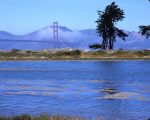 Photographed with twin Mamiya C220 cameras with 135mm lenses. I used Provia 100F pushed one stop. I’m fond of the surreal effect of slightly hyper images taken with zoom lenses. If I take the time to calibrate the twin release cable the Mamiya shutters are easy to sync up. You can see a bird flying in the distance in this shot with no rivalry.
Photographed with twin Mamiya C220 cameras with 135mm lenses. I used Provia 100F pushed one stop. I’m fond of the surreal effect of slightly hyper images taken with zoom lenses. If I take the time to calibrate the twin release cable the Mamiya shutters are easy to sync up. You can see a bird flying in the distance in this shot with no rivalry.
Patrick Dougherty “On The Fly” at UVA, 2013
Patrick Dougherty came to Charlottesville a couple of years ago, and I undertook to document his work. If you google his name, you’ll soon find lots of background information that I need not repeat here. Patrick was in town for about a month, commissioned by UVA Arts to make a stick sculpture in the (then brand new) Arts commons, right next to Ruffin Hall (which some of you know as one of my “clear buildings”).
Before his arrival, a crew of local volunteers will have assembled. In his first week, Patrick gets to know his volunteers in the work to gather his sticks. Patrick’s raw material is young saplings. He’ll correspond with people in the area, to find “doomed” saplings – i.e. saplings in wooded areas that are about to be clear cut. So he tries not to harvest saplings that would otherwise grow into mature trees.
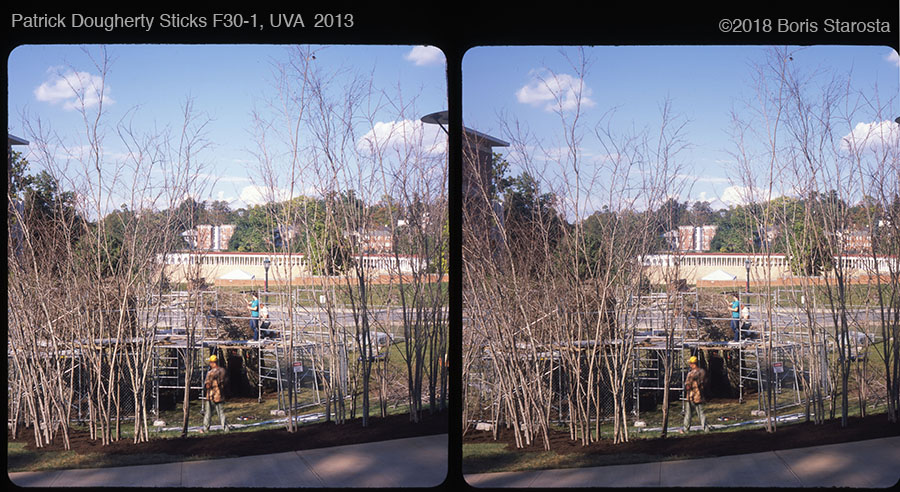
After a week of gathering saplings with his volunteers, the work on the sculpture begins. The first slide shows some of the initial work: saplings have been stuck straight into the ground, pressed into ground some four or five feet if possible. Each sculptural structure will be anchored by a few very large and strong saplings. These will be placed into boreholes that were drilled first. At this point, volunteers keep busy preparing the saplings for integration into the sculpture – which mainly involves removing all the leaves. Throughout the work, more and more saplings are trucked in from whereever they had been cut.
Once the installation’s initial layout is secured with these larger saplings, then the work can proceed with smaller saplings and “sticks.” My (uneducated) impression is that the sculptures are more or less woven into place. It is weaving with sticks. Dougherty uses no fasteners of any kind. No nails, screws, twine, rope, zip-ties, nothing of the kind! Only the sticks. The work proceeds for about two more weeks, at which point the sculpture will be mostly complete.
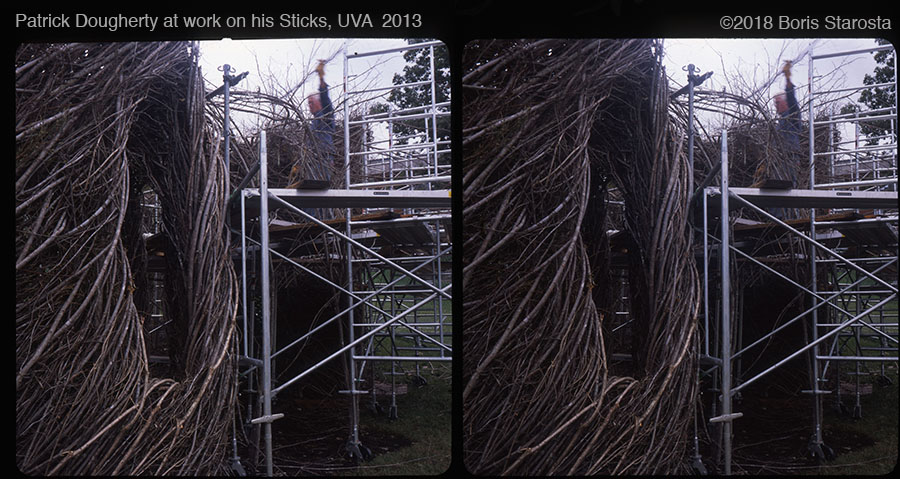
His structures thus fashioned can get quite large. Although the one he built at UVA was nowhere more than about ten feet tall, others I’ve seen depicted online can be multiple stories tall. They are also very strong. Dougherty typically specifies that his installations should be taken down after a year to 18 months. But for some reason, this one at UVA was left in place for over three years! (UVA wanted to get its money’s worth, and I bet Dougherty had to remind the university to take it down). Surprisingly, even at three years old, the sculpture didn’t look all that bad – it got a little shop worn around the edges, and some of the structures had started to sag a bit. (I should have photographed it at the end of its life, but I failed to do so).
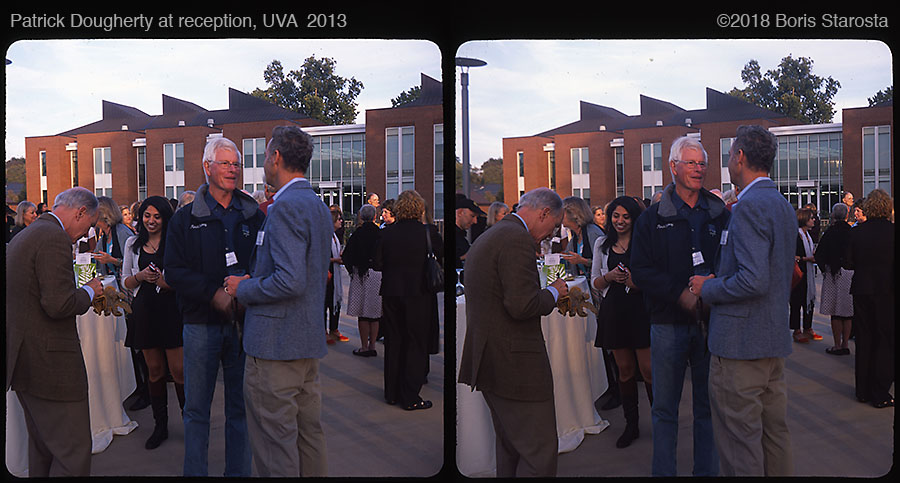
In the fourth week of his visit, Patrick tidies up loose ends and gets ready for his next project. I include a slide taken at a farewell reception, of Patrick talking with one of the UVA big wigs who funded the project; and a slide showing the finished project with all (or most) of the volunteers standing with Patrick for a portrait (that last slide was helpfully exposed by my beloved Michele). Patrick makes about ten sculptures per year in this fashion: one per month, anywhere in the world. Then he takes off two months to be at home with his family.
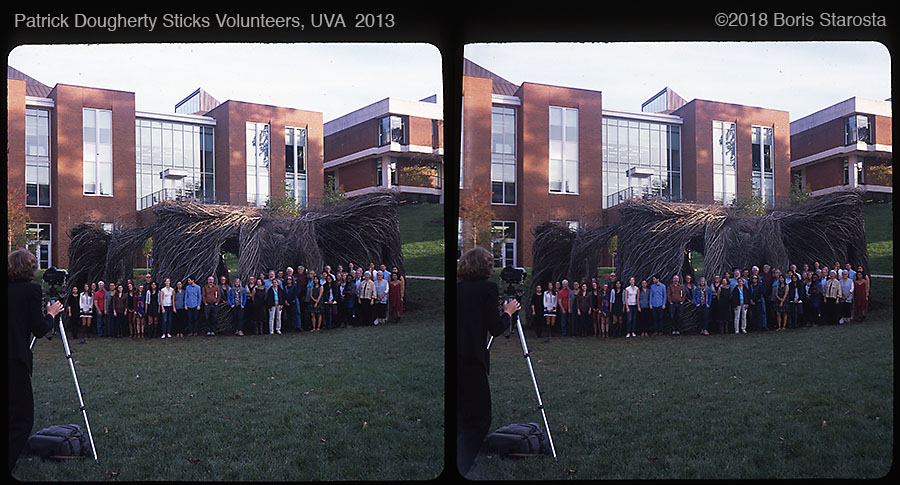
PS
I did undertake a 3d timelapse of the birth and subsequent aging of the sculpture: I shot two stereo pairs per day for about four months. After an initial review of the imagery, I decided that it was not looking very “good” (constantly and rapidly shifting light was very distracting in the video), so I didn’t do anything more with it. But you can see some of the beginnings of aging, if you look closely:
Ape Caves, Mt. St. Helens, Washington
The Ape Cave is a lava
tube created about 3,000 years ago. It heads south from Mt. St. Helens volcano, stretching for about a mile and a half, narrowing and expanding into a long stretch of total darkness.

My girlfriend and a couple of friends hiked over the top of the tube to the northern entrance of the cave. By doing so, we would be able to walk through the lava tube more or less downhill, to make things a little easier. It takes a bit of time to navigate the tube due to it’s loose rocks and uneven ground. In some spots, you needed to ‘drop down’ a few feet to a lower section of the tube to continue on. This is not a place for people who are claustrophobic or those who are afraid of the dark.
It’s pitch black down there, and very good headlamps are needed to avoid any injuries. For me, this was my second time through the cave and knowing how dark it was, I brought along a pair of Profoto B1 500 watt lights to help fill the space with light.
One of the lights can be seen at the far end of the cave in the photo. This was a mistake mind you, but one that I let slide for the sake of correct exposure, composition, etc. This was taken with my Sputnik on Fujifilm Provia 100f, using a Profoto Air Remote as a trigger. I had also brought along my digital Canon 5D Mk III, but no 3D was taken with it.
If you do happen to find yourself in the vicinity of Mt. St. Helens, have a good set of knees and a decent headlamp, then I would recommend a visit.
There is a way to see a smaller section of the cave, without going the whole mile and a half. I believe it’s about a quarter of the cave, and well worth a look.
